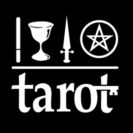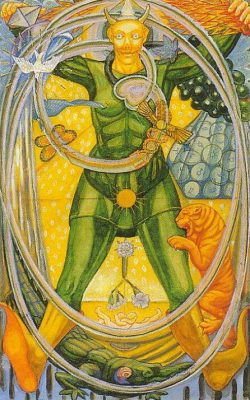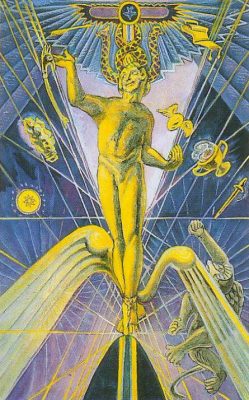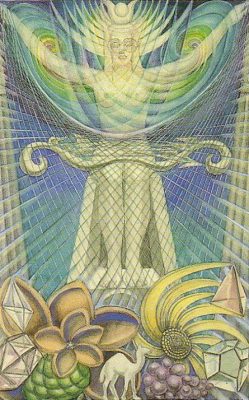For those of you who are comfortable with using Elemental Dignities and feel the need to be stretched, here is one way the system can be developed. The truth is, there may well be five categories of Tarot not four. The Golden Dawn hints at such but does not give details.
When we read Tarot using Elemental Dignities, the four elements are a fundamental aspect of the teaching. Each card interacts equally with each other, but the outcome can be stronger or weaker, more active, or less passive, depending on the surrounding cards. When we deal with the energy levels of a greater number of cards, we see a hierarchy of dignity developing.
Transforming Energy through EDs
Having worked with Elemental Dignities for years, I have noticed certain anomalies, but it has taken time to clarify the rules which might explain them, once I got past the idea that it was my experience that was at fault. The study of EDs is the study of the transformation of energy through the four elements. The Rules of EDs are clear, but it seems that some hint at greater and profound transformations happening within the reading, which give the Reader clues about how to advise on spiritual transformation for the Querent.
Kabbalistic knowledge and the teaching of Tarot gives us clues that this interaction is not as rigid as the rules of Elemental Dignities suggest. To begin, here are the cards that are in the class of Spirit or Akasha:
Supernal – Major
Minor
- Four Aces – Kether
- Four Tens – Malkuth
Court Cards
- Four Princesses
Each group of the Tarot is represented in roughly the correct proportions – three Major arcana, eight Minor arcana and four Court cards. All are associated with either Kether or Malkuth, and as we know, ‘Malkuth is Kether, but after another way’. Since I doubt you have seen such a group before, here is some internal evidence from the Golden Dawn, Tarot and Kabbalah that it exists.
Major arcana and Kether
The Fool, Magician and High Priestess are associated with Paths on the Tree of Life that originate from Kether, the Crown, which is beyond the four elements. Astrologically, the Magus is associated with Mercury, a planet that does not have an elemental attribution – it takes on the attributes of the sign or house it resides in. The Fool is associated with Uranus, a planet that brings instability and change in whatever region of the horoscope we find it. Likewise, the High Priestess as the Moon brings change and fluctuation.
Liber 777 is interesting in this respect. Columns VI and VII show that there is no elemental attribution for these Paths. Air is attributed to the Fool, but it is defined as RVCh, Spirit. Note also that the Fool is attributed to Air, but when we consider the YHVH attributions, this Atziluthic level is Fire.
The Magus has a slightly different status. Most depictions shows the Magus having mastery over the four elements, which is an attribute of Spirit. The balanced appearance of the four elements is a sign of Akasha, known as Osiris in Enochian chess.
The Naples Arrangement is useful here. Kether is described as “The Point: positive yet indefinable”. Chokmah is “The Point: distinguishable from 1 other.” It is only when we get to Binah that a relationship is established – The Point: defined by relation to 2 others”
Minor arcana
The Golden Dawn describes the Aces as the ‘Roots of the Powers of the Elements’:
The first in order and appearance are the four Aces, representing the force of the Spirit acting in, and binding together the four scales of each element and answering to the Dominion and Letters of the Name in the Kether of each. They represent the Radical or Root-Force and are said to be placed on the North Pole of the Universe, wherein they revolve, governing its revolution, and ruling as the connecting link between Yetzirah and Assiah.
This indicates that the Aces are Spirit, not the elements themselves. When considering Elemental Dignities, we need to do the same. Papus describes the Aces as ‘commencement of commencement’, or in other words, beginning of the beginning. Nothing has actually happened yet.
The Tens are an appendage to the Tree of Life, and in Papus’ system have an indeterminate outcome depending on ‘the card which follows it’. There is the objection that Malkuth represents Earth, but this is illusory. In Kabbalah, the element Earth does not really exist. The ‘Mother Letters’ represent Fire, Water and Air – Earth is not represented.
Court Cards
The Princesses have a unique status within the Tarot. Although they are attributed to the four elements, they are part of Malkuth, which as we have seen has indeterminate status, a characteristic discussed here. The Princesses are associated with Kether, particularly the Aces. See the Pole Star for more detailed arguments. Unlike the King/Knights, Queen and Princes, the Princesses do not have an astrological attribution. The Golden Dawn defines the powers of the Court cards thus:
- Potential Power is the King
- Brooding Power is the Queen
- Power in Action is the Knight
- Reception and Transmission is the Knave
Although we are not including the King, or the Fiery aspect of an element in this discussion, it is interesting that he is described as ‘potential power’ which is in accordance with his position at Chokmah, and with the Naples Arrangement quoted above. The Knave or Princess has an entirely different function to the other court cards. She is there to receive energy and to send it on to the next stage indicated by the Aces and North Pole as shown in the quotation above. It is quite possible that this energy is not necessarily transformed, something else to consider in Elemental Dignities. The general indications are:
Fool
But the essential of this card is that it represents an original, subtle, impulse or impact, coming from a completely strange quarter.All such impulses are right, if rightly received; and the good or ill interpretation of the card depends entirely on the right attitude of the Querent. (Book of Thoth)
The Magus
Mastery of the Four Elements. Communication
High Priestess
Change, fluctuation, increase (Book of Thoth)
Four Aces
Root of the Power of the Element – ‘Commencement of Commencement’ (Papus)
Four Tens
Indeterminate (Papus)
Four Princesses
‘A woman on the brink of transformation’ (Princess of Disks, Book of Thoth)
Note the nonspecific nature of the interpretations. Events have either not happened, of if they have, we are not clear about what is happening. In this context, we might include the Universe or World in these categories, since it is either Earth or Saturn (Binah). The Path of The World connects Hod to Malkuth, and the interpretation of this card is that it points to either the matter at hand, or the end of a situation.
Why Malkuth is different to the other Sephiroth
In her ‘Mystical Qabalah, Dion Fortune draws attention to the unique status of Malkuth. She gives a ‘seed-sentence’ which works on the subconscious mind of the reader: “Kether is the Malkuth of the Unmanifest.” She goes on to quote McGregor Mathers: “The limitless ocean of negative light does not come from a centre, for it is centreless, but it concentrates a centre, which is the number One of the manifested Sephiroth, Kether, the Crown, the First Sephirah.” These quotations come from the chapter about AYN, the Negative, found above Kether. Clearly, Malkuth is far more complex than many students of Tarot realise. Later, Dion Fortune gives a simpler understanding of why Malkuth is not Earth in the general sense we understand:
Our consciousness being in the element of Earth, we do not need the symbol of earth in our calculations when we make contact with the Unseen, so we leave it out and then find ourselves with the correct set of correspondences. Malkuth is all the earth we need for practical purposes. Dion Fortune, The Mystical Qabalah
Applying Spirit to Elemental Dignities
Before I codified the above information, I was perplexed in readings by the fact that these cards did not seem to have such an inimical aspect. Even though they have elemental attributions, do not have such harsh effects. Equally, the interpretation of them is dependent on the surrounding cards. Another way of looking at the Spirit cards is that they show areas where either change is about to happen and the Querent is either unaware of this change, or that they represent areas that the Querent has only vague intimations. Do not get me wrong – apply the rules of friendship and enemies, active and passive equally to all the cards, but do have an awareness of subtleties. The interpretation of each card does not change – the prognostication of the Ten of Swords is as bad as it always was!



